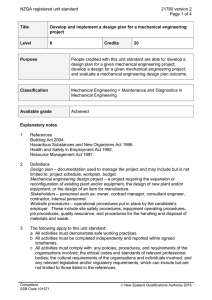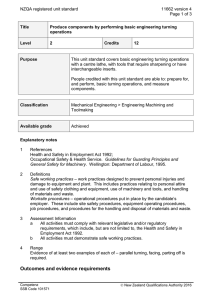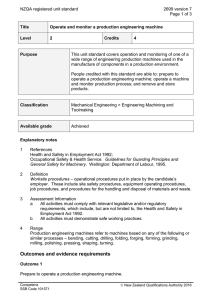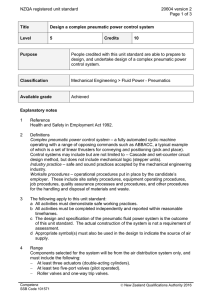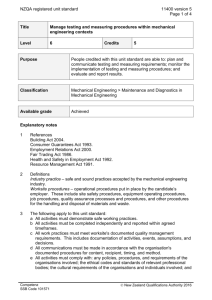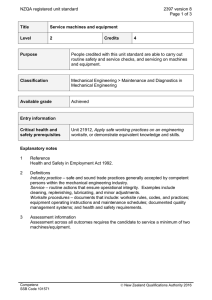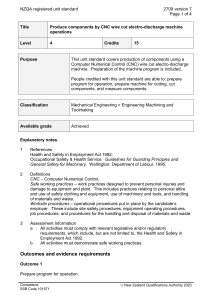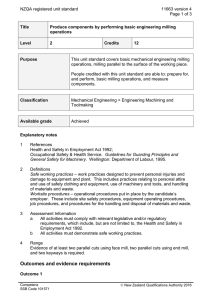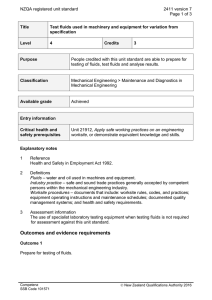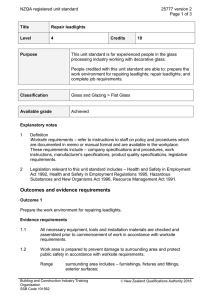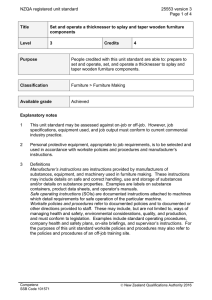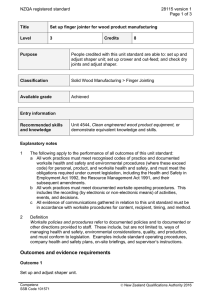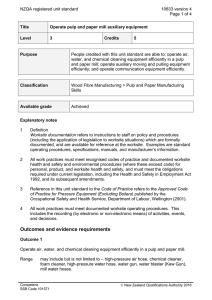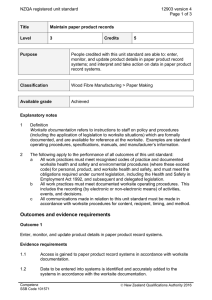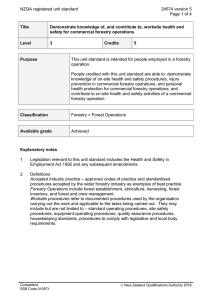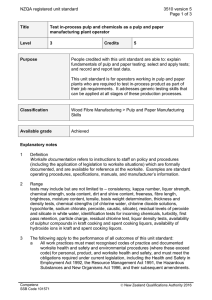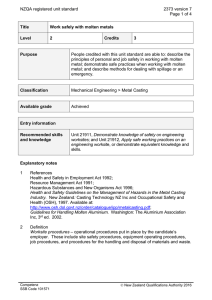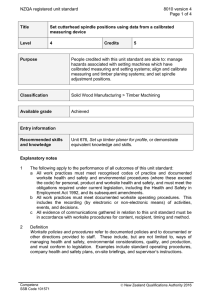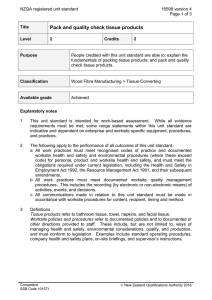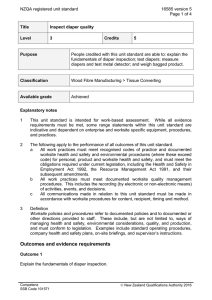Document 15207914
advertisement
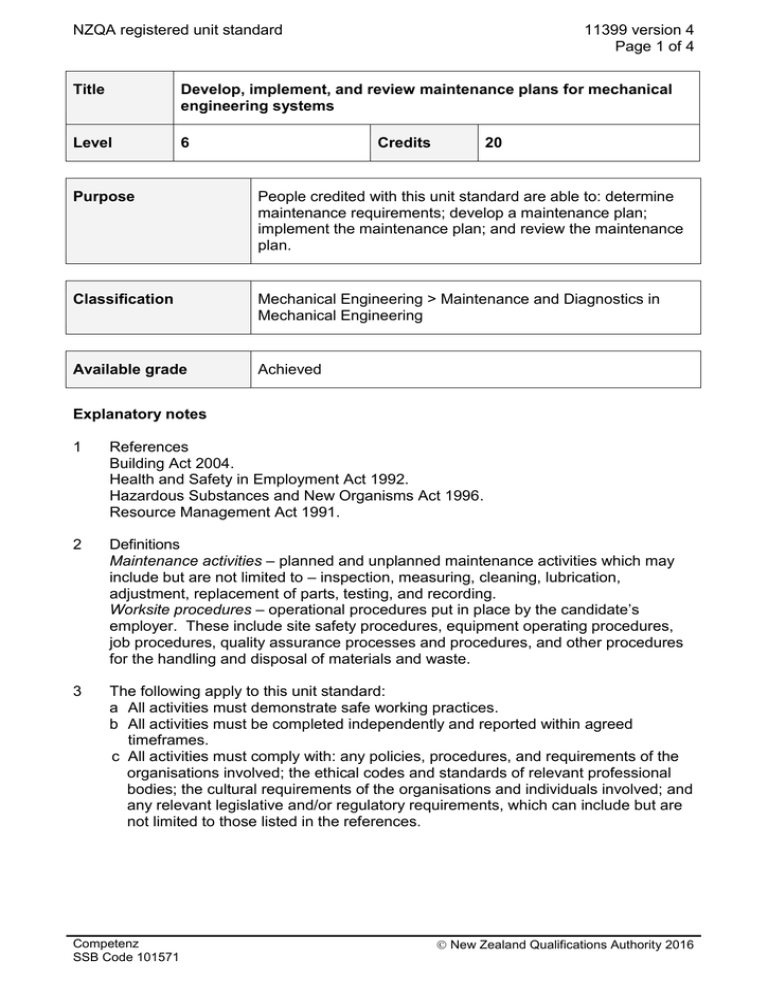
NZQA registered unit standard 11399 version 4 Page 1 of 4 Title Develop, implement, and review maintenance plans for mechanical engineering systems Level 6 Credits 20 Purpose People credited with this unit standard are able to: determine maintenance requirements; develop a maintenance plan; implement the maintenance plan; and review the maintenance plan. Classification Mechanical Engineering > Maintenance and Diagnostics in Mechanical Engineering Available grade Achieved Explanatory notes 1 References Building Act 2004. Health and Safety in Employment Act 1992. Hazardous Substances and New Organisms Act 1996. Resource Management Act 1991. 2 Definitions Maintenance activities – planned and unplanned maintenance activities which may include but are not limited to – inspection, measuring, cleaning, lubrication, adjustment, replacement of parts, testing, and recording. Worksite procedures – operational procedures put in place by the candidate’s employer. These include site safety procedures, equipment operating procedures, job procedures, quality assurance processes and procedures, and other procedures for the handling and disposal of materials and waste. 3 The following apply to this unit standard: a All activities must demonstrate safe working practices. b All activities must be completed independently and reported within agreed timeframes. c All activities must comply with: any policies, procedures, and requirements of the organisations involved; the ethical codes and standards of relevant professional bodies; the cultural requirements of the organisations and individuals involved; and any relevant legislative and/or regulatory requirements, which can include but are not limited to those listed in the references. Competenz SSB Code 101571 New Zealand Qualifications Authority 2016 NZQA registered unit standard 4 11399 version 4 Page 2 of 4 Range Competence is to be demonstrated on a mechanical engineering system such as: boiler including feed systems, automated printing press with services, large machining centre with feeding devices, large furnace, complete processing line, complete packaging line. Outcomes and evidence requirements Outcome 1 Determine maintenance requirements. Evidence requirements 1.1 Specified maintenance activities and their frequency are established in accordance with worksite procedures, equipment’s operational significance, and regulatory requirements for safety, availability, and technical integrity. Range 1.2 frequency may include but is not limited to – daily, weekly, monthly, annually. Standards of maintenance are quantified in accordance with manufacturer’s specifications and worksite procedures. Range maintenance may include but is not limited to – parts replacement, types of lubricants, component tolerances. Outcome 2 Develop a maintenance plan. Evidence requirements 2.1 Plan includes the maintenance requirements for all relevant components and/or equipment. 2.2 Plan identifies the stakeholders responsible for maintenance activities, and specifies the frequency of maintenance activities, recording requirements, reporting requirements, contingency actions, and review requirements. 2.3 Plan meets the worksite requirements for cost-effectiveness and productivity. Range may include but is not limited to – scheduling, uptime requirements, sparing requirements, repair provision. 2.4 Plan specifies materials required, sources of supply, and timeframes for availability. 2.5 Plan contains a level of detail such that standard operating procedures for maintenance can be derived from it in accordance with worksite procedures. 2.6 Plan is developed within delegated authority and in consultation with relevant Competenz SSB Code 101571 New Zealand Qualifications Authority 2016 NZQA registered unit standard 11399 version 4 Page 3 of 4 stakeholders. Outcome 3 Implement the maintenance plan. Evidence requirements 3.1 Candidate ensures resources are available when required in accordance with the plan requirements. Range resources may include but are not limited to – materials, spare parts, trained personnel. 3.2 Monitoring of maintenance activities establishes the degree of conformity with the maintenance plan. 3.3 Where necessary, contingency actions re-align maintenance activities with plan. Range may include but is not limited to – use of alternative equipment, use of sub-contractors, servicing of equipment. 3.4 Where amendments or re-aligned activities are required, they comply with worksite procedures and regulatory requirements, and are communicated to all affected stakeholders within agreed timeframes. 3.5 Reporting requirements are carried out in accordance with plan requirements and worksite procedures. Outcome 4 Review the maintenance plan. Evidence requirements 4.1 Plan is evaluated in terms of meeting the maintenance requirements. 4.2 Processes used to develop, implement, and monitor the plan are described and are in accordance with worksite procedures. 4.3 Contingency actions implemented are described and reasons for those actions are identified. 4.4 Communication activities with stakeholders are described and are in accordance with worksite procedures. Range 4.5 stakeholders may include but are not limited to – manager, contractor, internal personnel. Where possible, improvements to the plan or the planning cycle are recommended in accordance with worksite procedures. Competenz SSB Code 101571 New Zealand Qualifications Authority 2016 NZQA registered unit standard Planned review date 11399 version 4 Page 4 of 4 31 December 2016 Status information and last date for assessment for superseded versions Process Version Date Last Date for Assessment Registration 1 24 February 1998 31 December 2011 Revision 2 18 September 2001 31 December 2011 Review 3 27 October 2005 31 December 2014 Review 4 17 November 2011 N/A Consent and Moderation Requirements (CMR) reference 0013 This CMR can be accessed at http://www.nzqa.govt.nz/framework/search/index.do. Please note Providers must be granted consent to assess against standards (accredited) by NZQA, before they can report credits from assessment against unit standards or deliver courses of study leading to that assessment. Industry Training Organisations must be granted consent to assess against standards by NZQA before they can register credits from assessment against unit standards. Providers and Industry Training Organisations, which have been granted consent and which are assessing against unit standards must engage with the moderation system that applies to those standards. Requirements for consent to assess and an outline of the moderation system that applies to this standard are outlined in the Consent and Moderation Requirements (CMR). The CMR also includes useful information about special requirements for organisations wishing to develop education and training programmes, such as minimum qualifications for tutors and assessors, and special resource requirements. Comments on this unit standard Please contact Competenz on qualifications@competenz.org.nz if you wish to suggest changes to the content of this unit standard. Competenz SSB Code 101571 New Zealand Qualifications Authority 2016

